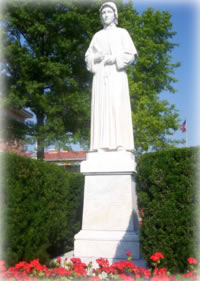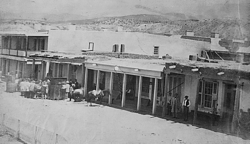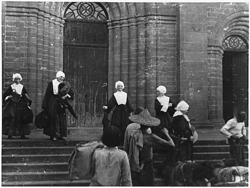Spotlight Archive
This summer, the Sisters of Charity in the United States celebrate the 200th anniversary of their founding by St. Elizabeth Ann Seton. From education, to social services, to health care, the impact of these women religious on the life of the church and the nation has been immense.
 The Sisters of Charity trace their origins to the Daughters of Charity, founded by Saints Vincent de Paul and Louise de Marillac in France in the seventeenth century. It was this model of religious life that Elizabeth Seton emulated when she determined to found a religious congregation in her young nation. A widow and a convert from Episcoplianism, Seton had been invited to Baltimore to open a school for Catholic children. She quickly gathered around her like-minded women who wished to dedicate their lives to the service of Christ and their fellow human beings.
The Sisters of Charity trace their origins to the Daughters of Charity, founded by Saints Vincent de Paul and Louise de Marillac in France in the seventeenth century. It was this model of religious life that Elizabeth Seton emulated when she determined to found a religious congregation in her young nation. A widow and a convert from Episcoplianism, Seton had been invited to Baltimore to open a school for Catholic children. She quickly gathered around her like-minded women who wished to dedicate their lives to the service of Christ and their fellow human beings.
Seton soon organized her band of followers as a vowed congregation of women religious. Selecting the rule of the Daughters of Charity, Mother Seton and her fellow sisters took their first vows July 31, 1809, as a distinct American congregation, the Sisters of Charity of St. Joseph. They settled at a remote location near Emmitsburg, Maryland.
In response to a number of requests from bishops around the country, sisters began establishing foundations in several locations. In 1817, three sisters opened an orphanage in New York. In October 1829, four sisters opened St. Peter’s School in Cincinnati, the first enduring women’s religious community in the Northwest Territory.
Over time, several divisions occurred within the Sisters of Charity family. The Sisters of Charity of New York was the first to branch off in 1846. In 1850, the Emmitsburg community affiliated formally with the French Daughters of Charity, prompting the Cincinnati sisters to seek independence (1852). Subsequent congregations formed, including the Sisters of Charity of St. Elizabeth (Convent Station, New Jersey, 1859), and the Sisters of Charity of Seton Hill (Greensburg, Pennsylvania, 1870).
Meanwhile, other congregations modeled on St. Elizabeth’s but established independently were initiated. In the Diocese of Bardstown, Kentucky, Mother Catherine Spalding led the Sisters of Charity of Nazareth (1812). In Charleston, South Carolina, Bishop John England founded the Sisters of Charity of Our Lady of Mercy in 1829.
The sisters everywhere soon extended their apostolate into charitable work for the sick and indigent. They served in the first American hospital, the Baltimore Infirmary, as well as the first Catholic hospital in the country, the Mullanphy Hospital in St. Louis. Other early health care institutions sponsored by the sisters were St. Vincent’s Hospital in New York, established by Mother Angela Hughes in 1849, and Good Samaritan Hospital in Cincinnati (1852).
By the time of the Civil War, members of the Sisters of Charity, along with several other groups of women religious, were among the best organized and most skilled nurses in the country. Sisters of Charity were among the hundreds of American sisters who served during the conflict, administering aid to casualties, blue and gray alike. Sister Anthony O’Connell of the Cincinnati congregation was nicknamed “Angel of the Battlefield” for her distinguished service.
 The Cincinnati and Kentucky communities were springboards for westward expansion in the late nineteenth century. Sisters of Charity established the first hospital in the New Mexico Territory (St. Vincent, Santa Fe). Sister Blandina Segale wrote colorful letters and journals of her western experience as a consecrated religious; they were later parlayed into articles, movies, and plays. The Leavenworth, Kansas, Sisters of Charity grew from the Nazareth congregation; they continued the tradition of health care innovation by establishing the first non-military hospital in the state of Kansas (1863).
The Cincinnati and Kentucky communities were springboards for westward expansion in the late nineteenth century. Sisters of Charity established the first hospital in the New Mexico Territory (St. Vincent, Santa Fe). Sister Blandina Segale wrote colorful letters and journals of her western experience as a consecrated religious; they were later parlayed into articles, movies, and plays. The Leavenworth, Kansas, Sisters of Charity grew from the Nazareth congregation; they continued the tradition of health care innovation by establishing the first non-military hospital in the state of Kansas (1863).
Other pieces of the Sisters of Charity family formed in diverse ways and places. Mary Frances Clarke and four companions emigrated from Ireland to Philadelphia, arriving at Old St. Joseph’s Church in 1833. Their apostolate was teaching the children of the Irish immigrants, and soon established themselves as a religious order, the Sisters of Charity of the Blessed Virgin Mary. Nativist violence in Philadelphia encouraged the sisters to accept the invitation of the bishop of Dubuque, Iowa, and the entire congregation moved west in 1843.
In 1851, French sisters settled in Cleveland, becoming the Sisters of Charity of St. Augustine. Newly arrived French sisters also formed the Sisters of Charity of the Incarnate Word in Galveston (1866). Immigration similarly brought the Vincentian Sisters of Charity from Austria-Hungary to Pittsburgh in 1902 to serve a growing Slovak Catholic population.
Education being central to the Sisters of Charity’s work since the beginning, it is not surprising that they were pioneers in women’s education. The New Jersey sisters founded the College of St. Elizabeth in 1899, and a member of the same congregation became ten years later the first American sister to earn a doctorate. In the 1880s, the Cincinnati group began constructing its current motherhouse in Cincinnati, Mount St. Joseph, and in 1920, the College of Mount St. Joseph was founded there.
 In 1908, the United States was formally removed from the jurisdiction of the Society for the Propagation of the Faith. Henceforth, the American Church would cease to be a recipient of foreign missions and begin to send its own evangelists abroad. New York sisters had already begun a mission in the Bahamas in 1889. Cincinnati sisters began their foreign missionary activity in 1928, when six members arrived in Wuchang, China. They established various institutions, including a Sisters of Charity novitiate, but their progress was halted and undone after 1950 by the Communist Revolution. Other missions could be found in Italy, Latin America, Poland, and Armenia.
In 1908, the United States was formally removed from the jurisdiction of the Society for the Propagation of the Faith. Henceforth, the American Church would cease to be a recipient of foreign missions and begin to send its own evangelists abroad. New York sisters had already begun a mission in the Bahamas in 1889. Cincinnati sisters began their foreign missionary activity in 1928, when six members arrived in Wuchang, China. They established various institutions, including a Sisters of Charity novitiate, but their progress was halted and undone after 1950 by the Communist Revolution. Other missions could be found in Italy, Latin America, Poland, and Armenia.
With most other groups of women religious, the number of Sisters of Charity peaked in the mid-1960s; the Cincinnati branch alone had 1500 sisters at the time. The turmoil following Vatican II affected women religious at least as much as any other American Catholic group. Like many other congregations, the Sisters of Charity modified their governance, religious habit, and service focus. They experienced declining numbers of new entrants, but remained involved in both traditional apostolates such as education and health care and new activities such as social and peace activism.
Sisters of Charity institutions adapted to the changing circumstances of American life. The Sisters of Charity Health Care System oversaw all the community’s hospitals when it was formed in 1979. Less than two decades later, it too was subsumed by a larger entity, Catholic Health Initiatives.
Fewer sisters now fill the staffs of schools and universities or toil in the wards of hospitals, but the Sisters of Charity remain a vital part of the American Church. Their historical legacy, moreover, is monumental: to a remarkable extent, they built the institutions, served the needy, and educated the citizens of a growing nation.
©2009 CatholicHistory.net. Posted May 12, 2009.
Photos, from top: Elizabeth Ann Seton statue, courtesy of the Seton Shrine Center, Emmitsburg, Md.; Santa Fe, 1866, courtesy of National Archives and Records Administration (unrestricted); Sisters of Charity at Yukiang mission, 1942, courtesy of National Archives and Records Administration (unrestricted).
Sources and Further Reading
K. Lawlor, "Sisters of Charity of the Blessed Virgin Mary"; G. Stewart, "Women Religious in America,"
